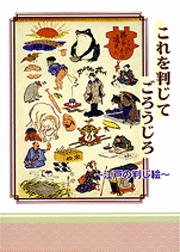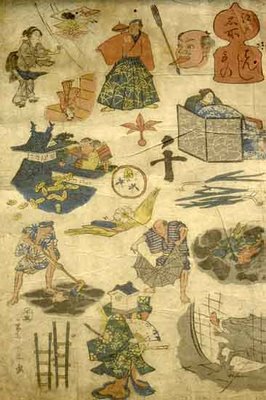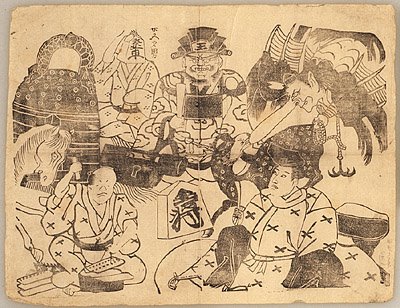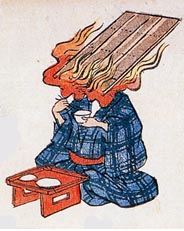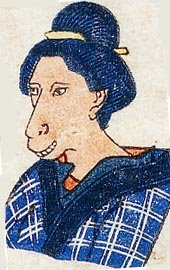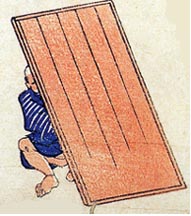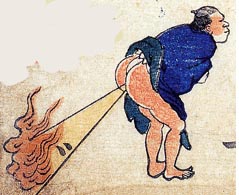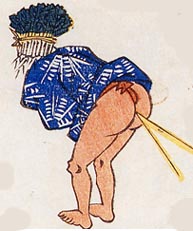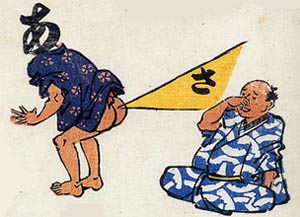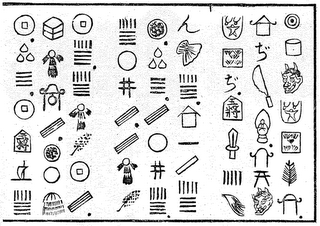:::::::::::::::::::::::::::::::::::::::::::::::::::::::::::::::::::::::::::::::::::::::::::::::::::::
Stones and Daruma 石、岩とだるま
だるまいし、達磨石、石達磨
Stone Daruma at a Marugame street corner, Shikoku

Shikoku Pilgrims, May 2006

Somebody put two stones for Daruma as feet.
- Shared by Ryosuke Ueda -
Joys of Japan, 2012
a stone Daruma
with stone feet -
take a walk !
Gabi
Walking with style
The gallery daruma
Oh! So a la mode! (^ ^)
Ryosuke Ueda
:::::::::::::::::::::::::::::::::::::::::::::::::::::::::::::::::::::::::::::::::::::::::::::::::::

軽石だるま(鹿児島県) Karuishi Daruma
Stone Daruma from Lava, Kagoshima prefecture.
軽石という素材でだるまをつくってしまうという発想が面白い。
南国鹿児島には個性の強い玩具が多い。
http://www008.upp.so-net.ne.jp/u1cku/gangu.htm
karuishi ningyoo 軽石人形 dolls from lava

The God of the Fields on the right.
The stone comes from the active volcano at Sakurajima. Many represent the God of the Fields 田の神 and a long-living Daruma 寿だるま. The zodiac animals are also made.
They are not really carved, but scratched from pieces of lava.
Ta no kansa 田のカンサア the God of the Fields,
comes in various forms in different villages.
. Regional Folk Toys from Japan - Kagoshima .
. Ta no Kami, God of the Rice Fields 田の神さま .
::::::::::::::::::::::::::::::::::::::::::::::::::::::::::::::::::::::::::::::::::::::::::::::::::::::::::::::::::::::::::::::::::::

hight - 6.5 cm
- source : Daruma on Ebay
::::::::::::::::::::::::::::::::::::::::::::::::::::::::::::::::::::::::::::::::::::::::::::::::::::::::::::::::::::::::::::::::::::

Stone painting from Ishino san

source : facebook, Takayoshi Shitara
From 西新井大師参道
Nishi-Arai Daishi Temple / Nishi Ii Daishi Adachi Tokyo
Nr. 26 - 西新井大師 Nishi-Nii Daishi 第二十六番
. 関東三十六不動霊場
Pilgrimage to 36 Fudo Temples in Kanto / Bando .
:::::::::::::::::::::::::::::::::::::::::::::::::::::::::::::::::::::::::::::::::::::::::::::::::::

source : Tomohisa on facebook
島根県大田市 Shimane, Ota town
:::::::::::::::::::::::::::::::::::::::::::::::::::::::::::::::::::::::::::::::::::::::::::::::::::::
From 桂化石
This one is about 7,5 kilograms heavy.
Hight 24, width about 30 cm. With a wooden stand.
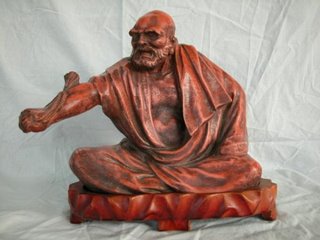
From All Sides
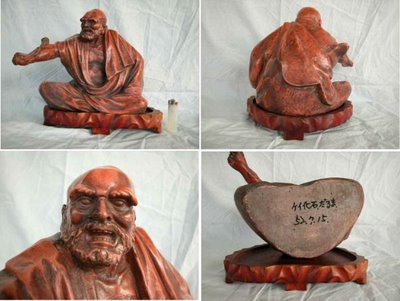
From my friend Ishino.
:::::::::::::::::::::::::::::::::::::::::::::::::::::::::::::::::::::::::::::::::::::::::::::::::::


Photos from my friend Ishino
This stone weights 550 grams.
Its size is 100×73×45 mm.
:::::::::::::::::::::::::::::::::::::::::::::::::::::::::::::::::::::::::::::::::::::::::::::::::::
At the Pass Mitsu Toge 三つ峠
The sanskrit letter on the stone reads "aak" and is a symbol of Dainichi Nyorai.

© PHOTO : azami.cool.ne.jp
:::::::::::::::::::::::::::::::::::::::::::::::::::::::::::::::::::::::::::::::::::::::::::::::::::
At the temple Shuzen-Ji (Shuuzenji) 修禅寺(しゅうぜんじ)

© PHOTO : ayablogdiary
:::::::::::::::::::::::::::::::::::::::::::::::::::::::::::::::::::::::::::::::::::::::::::::::::::


CLICK for more Ishi Daruma, Daruma Ishi !
:::::::::::::::::::::::::::::::::::::::::::::::::::::::::::::::::::::::::::::::::::::::::::::::::::::

Stone from River Shonaigawa, Aichi
:::::::::::::::::::::::::::::::::::::::::::::::::::::::::::::::::::::::::::::::::::::::::::::::::::::

Made by Saint Fugai 風外上人
風外蝸室. 風外道人こと風外慧薫上人 Fuugai Ekun at about age 60
at Kifune Jinja, Manazuru 貴船神社
Fugai was a Zen painter/monk in the Early Edo Period.
1568-1654
He was the head priest at temple 成願寺 in Sagami and later lived in a cave in Soga, then in Ishioka. When he felt his death coming at about 87 years of age, he had his parishioners dig a hole, grabed his paintings of Daruma and Hotei and died in the hole. This is why they called him "fuugai".
Fugai lived in a cave in Manazuru for a while.
source : myluxurynight.com
:::::::::::::::::::::::::::::::::::::::::::::::::::::::::::::::::::::::::::::::::::::::::::::::::::::
I have various other entries on this subject.
Here is a list to them.
Stones like Daruma 達磨石
BACKUP TEXT only
Cliff Buddhas Magaibutsu 磨崖仏
Suiseki ... 水石 ... Stone Appreciation .. だるま水石
Daruma Pebbles and Educationだるま小石
Daruma Petroglyphs in Mexico
Daruma Rock at Shiraishi Island 白石島のだるま岩
Stalagmite Daruma Shapes
Stalagmites, Ikura-Cave 井倉洞
Tokachi Daruma 十勝だるま From obisdian stone Hokkaido
Ishigami root Daruma from Philippe Boudin
Daruma Pilgrims in Japan: Heavy/light to lift stoned. Omokaru Ishi
Power Stones (chikara ishi) to test your strength
:::::::::::::::::::::::::::::::::::::::::::::::::::::::::::::::::::::::::::::::::::::::::::::::::::::
More Stone Daruma
In the category of stone sculpture, a crafted image of Daruma is known as a "Stone Daruma" (ishi Daruma 石だるま). These can have various forms, from large-scale figures to smaller-scale works. Sometimes the Daruma features are chiseled into an interestingly shaped stone. Sometimes the face is painted on a smooth, stream-worn pebble.
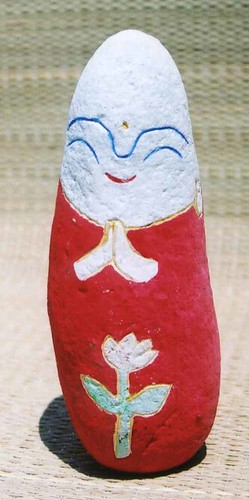
This is a little Kannon, which I got from a friend.

Let us look at one Daruma made of stone. He was made in China and is now sold in many stone-producing areas of Japan. I got this one near Tamakatsu from a local stone dealer. This Daruma comes in two sizes and since he is mashine-made, he has many identical brothers.
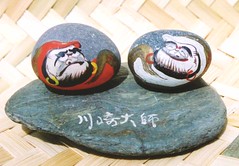
These two Daruma are painted in red and white on stone. The pebbles provide soft shapes on which to paint whimsical renditions of Darumas face. These tow are sold at a temple dedicated to Kooboo Daishi, whom we have met frequently. The Kawasaki Daishi Temple is located close to Tokyo and very famous for the crowds visiting during the first three days of the New Year. I tried once to go there too and had to stand in line from the station for three hours and not yet even reached the entrance gate when we gave up and posponed the visit to February.
. Kawasaki Daishi 川崎大師 and more Daruma
.................................................................................

We have already seen the pebbles from the Nachi area in the Kumano story.
. Kumano and Nachi 熊野と那智 Stone Daruma
.................................................................................
This is only the face of a beautiful Daruma of Stone, which I found many years ago in the garden of the Temple Gohyaku Rakan in Odawara. He is as big and looks just like the laquer statue which we saw in the ABC story. Maybe they were made from the same pattern?

Look at his laquer friend HERE
. WHO is Daruma ?
.................................................................................
Gohyaku Rakan 五百羅漢 Temples with 500 Arhat statues
. . . CLICK here for Photos !
Temple Buttsuu-ji 佛通寺 and 500 Arhats
The famous Daruma Temple Hoorin-ji in Kyoto
also has some stone statues, here are just two of them.
京都の法輪寺の石だる

fushiki Daruma 不識 "I do not know "

with eto zodiac animals all around
Hoorin-ji 京都の法輪寺 Horinji Temple in Kyoto
:::::::::::::::::::::::::::::::::::::::::::::::::::::::::::::::::::::::::::::::::::::::::::::::::::::

From the collection of Kido Takayoshi (1833 - 1877), displayed at his home
- reference source : 木戸孝允 -
:::::::::::::::::::::::::::::::::::::::::::::::::::::::::::::::::::::::::::::::::::::::::::::::::::::
Shizen 自然 Photoalbum with natural Daruma shapes
. My Photo Album
Stones formed like Daruma
. Magaibutsu 磨崖仏散歩 Stone Cliff Buddhas
:::::::::::::::::::::::::::::::::::::::::::::::::::::::::::::::::::::::::::::::::::::::::::::::::::::

IWA Daruma kun 岩だるまくん GANDARUMA
Iwate International Daruma
The World helps Iwate prefecture after March 11, 2011.
. Japan after the BIG earthquake March 11, 2011 .
:::::::::::::::::::::::::::::::::::::::::::::::::::::::::::::::::::::::::::::::::::::::::::::::::::::
[ . BACK to DARUMA MUSEUM TOP . ]
[ . BACK to WORLDKIGO . TOP . ]
:::::::::::::::::::::::::::::::::::::::::::::::::::::::::::::::::::::::::::::::::::::::::::::::::::::



















